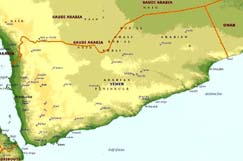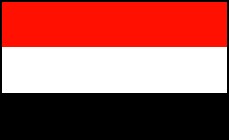-
-
- Yemen Map
|
-

-
- Middle East Map
|
|
-
|
- latest picture: Maarch 11, 2011
|
-
-
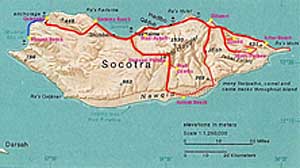
|
-
-
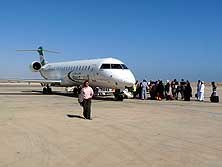
|
-
-
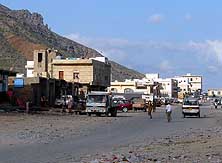
|
- 001
Map of Socotra, situated in the
- Indian Ocean, 210 miles from Yemen
- and 150 miles from Somalia
|
- 002
At the airport of Mukhalla on the
- Yemeni mainland, Liliana is ready to board
- the flight of Felix Airways to Socotra
|
- 003
The main road of Hadibo, the
- “capital” of Socotra, is caught
- by the morning light
|
-
- 1st Day: February 9th, 2011:
-
- We gaze out of the airplane window of Felix Airways. Below there is nothing than the
brown-reddish sand of the endless Arabian desert as far as our eyes can reach - the ocean
of sand of the Rub al Khali, the “Empty Quarter”. The seats opposite us are
taken by Arab women wearing a long black “Abaya” (robe) and a Niqab (veil) that
is covering their face, leaving only their expressive eyes free. Sitting separately from
their women – even in the plane – are their husbands, chatting animatedly.
|
-
-
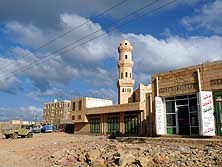
|
-
-
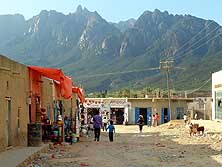
|
-
-
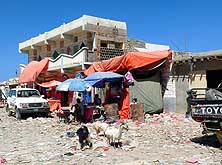
|
- 004
The minaret of the city
- mosque towers over Hadibo
|
- 005
A dramatic mountain range
- is looming behind Hadibo’s souk
|
- 006
A typical Yemeni road scene:
- Goats searching in the scattered garbage
|
-
- These people occupy half of the plane and are on the way back to their island: Socotra,
situated in the Indian Ocean, 1’400 sq.mi. big (only 15% bigger than Rhode Island),
240 miles from Yemen in Asia and 150 miles from Somalia with
about 60’000 people (b.t.w.: in October 2010, Somalia claimed for the 1st time
Socotra as its own). Separated for 6 millions of years from the African
continent, it has developed a unique flora and fauna found nowhere else in the world.
We are full of anticipation to be able to explore it during the next ten days because we
always had a special fascination for this part of the world.
|
-
-
-
-
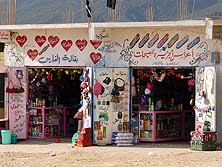
|
-
-
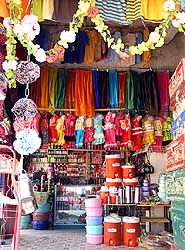
|
-
-
-
-
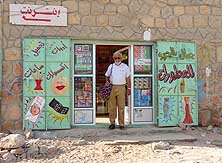
|
- 007
In Hadibo’s souk, shops attract
- customers with attractive facades …..
|
- 008
….. they are packed
- with all kind of goods, from
- textiles to household items
|
- 009
..... Is it a cosmetic shop where
- Emil stands? Not everyone can read.
- Therefore it is a good idea to paint
- some of the goods on the doors
|
-
- It is 3.45pm. At the small airport of the main town of Hadibo the turquoise Arabian Sea
is luring on one side and on the other side the reddish desert sand. Arriving directly
from Sharjah in the United Arab Emirates, it is our official
entry into Yemen. Much to our joy, the immigration officer uses a special
“Socotra” entry stamp. We fetch our luggage and are greeted by Abdullah, our
guide of “Meetaq Moqbel Abdullah Tour Organization”, which we booked via
internet. In a “LandCruiser FJ80” Ahmed, our driver, is waiting for us. These
two guys will escort us during our 10 days tour. There is no other solution – there
are no rental cars.
|
-
-
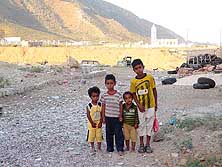
|
-
-
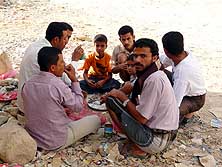
|
-
-
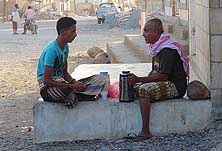
|
- 010
The four children bought a little
- something in the shop and are
- on their way home
|
- 011
In Yemen people are eating together
- by hand from one single metal plate, mainly
- pita bread (flat bread) and rice with a sauce
|
- 012
Tea time in front of the Taj
- Socotra Hotel in Hadibo. The heavily
- sugared tea is an energy source
|
-
- The evening light is lovely when we drive along the Eastern coast to Deleisha. A long
sandy beach – except of two fishermen totally deserted – a peaceful lagoon and a
white sand dune are greeting us, and the sun is just disappearing behind the rolling
hills. From here it is merely a stone’s throw along a stony track to Soq, our first
seaside tent camp. It is already dark when we arrive and are lead to our shed. It is right
beside a round table, taken over by a noisy tour group. Separated only by a wall of palm
leaves is the busy kitchen.
|
-
-
-
-
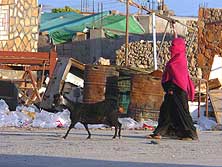
|
-
-
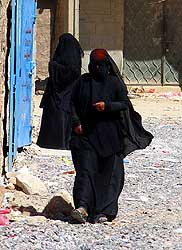
|
-
-
-
-
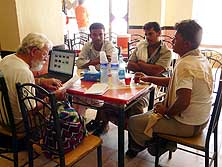
|
- 013
A covered up women
- leads her goat through a
- dusty road in Hadibo
|
- 014
Two completely covered
- up women in the souk of Hadibo
|
- 015
Discussion of our itinerary:
- Opposite Emil sits Meetaq, the local
- tour organizer, besides him Ahmed, our
- driver and aside Abdullah, our guide
|
-
- No, we definitely do not like it here! We explain Abdullah that we are not
“group” people, that we are not night persons and that a good sleep is very
important to us. He agrees to take us to a hotel in Hadibo for the night. The room at the
“Taj Socotra Hotel” is OK and at 8pm we are already in bed, the last two days
having been quite tiring: Twice in a row we got up at 2am and within 24 hours we flew
three different airlines.
|
-
-
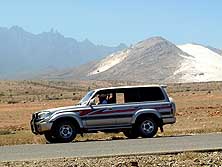
|
-
-
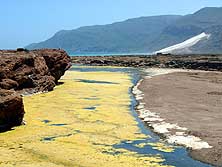
|
-
-
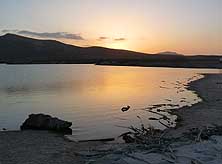
|
- 016
“Our” LandCruiser stops at
- the road side outside Hadibo
- while we take pictures
|
- 017
We are driving along the
- North coast Eastwards
|
- 018
An idyllic moment at Deleisha:
- The sun sets behind the hill
|
-
- 2nd Day: February 10th, 2011:
-
- It is 5am and it already dawns – the muezzin fell silent again. Hadibo awakens
slowly: Close to our hotel a covered-up woman is chasing her black goat through a dusty
alley, a merchant is opening the iron door of his shop, two hotel employees are sitting on
the bare stone floor drinking tea and four little boys leave the nearby shop. A strong
desert wind is blowing, swirling plastic bags in all colors around.
|
-
-
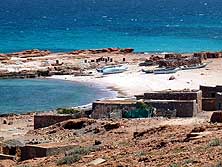
|
-
-
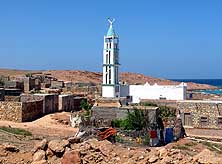
|
-
-
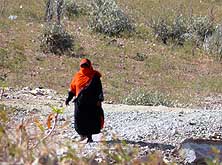
|
- 019
A small fisher settlement
- along the North coast
|
- 020
A mosque, a couple of stone houses,
- a little garden – a peaceful hamlet between
- Hadibo and the Northeastern tip
|
- 021
A lucky strike with the zoom:
- To take pictures of women is
- strictly prohibited on Socotra
|
-
- Two hours later, an intense sun is burning and the roaming goats squeeze to the shade of
house walls or below parked dusty LandCruiser – Yemen pure
as we remember it from 1996 when, coming from Oman, we
toured this country with our own car. At 7.30am our crew shows up and takes us for
breakfast. It is served in a local restaurant. Much to our surprise and to Emil’s joy
we also get triangle cheeses – three each – besides the still warm pita (flat
bread), honey, marmalade and Nescafe.
|
-
-
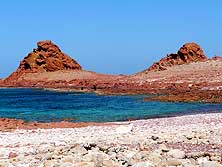
|
-
-
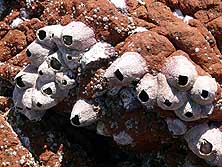
|
-
-
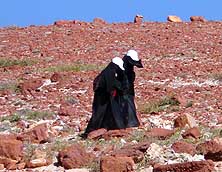
|
- 022
The two red rocks are the
- landmark of Dihamri, a marine
- protected area ideal for snorkeling …..
|
- 023
..... a kind of mussel
- sticks to the red rocks
- (name ???)
|
- 024
Two black veiled women with
- white baseball caps walk through
- the red stone desert
|
-
- With new energy and full of expectations we hit the road. On the good paved coastal
road, wedged between the Arabian Sea and a bizarre mountain range, we first head to the
East to Cape Dihamri, a marine protected area. This famous snorkeling spot announces
itself already from far with two red rocks towering out to the sea.
|
-
-
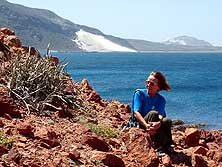
|
-
-
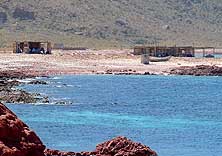
|
-
-
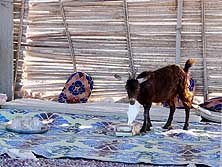
|
- 025
Liliana enjoys the view and
- the cooling breeze in Dihamri
|
- 026
The tourist camp at Cape Dihamri
- with its modest palm sheds open towards
- the sea. Equipped with mats, mattresses
- and cushions, they are the place to drink tea
- and eat. For the night tents are pitched up
|
- 027
The goat regards the facial
- tissues as a delicacy. It tears one
- after the other out of the box
- and chews it contently
|
-
- It is still quiet. Only one tour group, which stayed overnight, is present. There are
two simple sheds made from palm leaves, open towards the sea, equipped with mats, thin
mattresses and comfortable cushions. This is the place to relax, to drink the heavily
sugared tea, to eat, to chat or to simply take a nap.
|
-
-
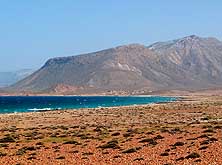
|
-
-
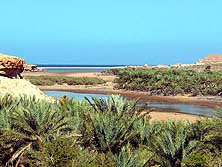
|
-
-
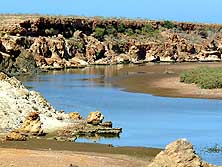
|
- 028
Bleak desert mountains and a blue ocean
- accompany us on the Northeasterly coast …..
|
- 029
..... while oases are a
- refreshing contrast in the desert .....
|
- 030
..... and a river promises
- relief from the desert sun
|
-
- Soon after our arrival, lunch is served – prepared by the camping staff. It
consists of rice with a viscous sauce made from potatoes, peas and tomato ketchup besides
a piece of fish and a plastic bottle of drinking water. Together with our guide and driver
we sit cross-legged on the mat on the ground (for Emil it is a torture) and eat with spoon
and fork (there is never a knife), while the two eat together traditionally by hand from a
big metal plate.
|
-
-
-
-
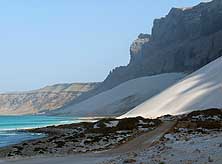
|
-
-
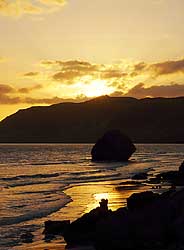
|
-
-
-
-
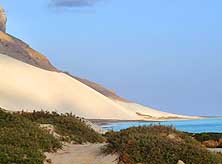
|
- 031
The wind has blown sand against
- the dark steep cliffs, which towers now
- in dunes of several hundred yards height
- at Arher in the Northeast .....
|
- 032
….. the sun rises at Arher …..
|
- 033
..... and bathes the sand
- dunes in a special light
|
-
- Boxes of facial tissues are lying around plentiful and are used bountiful. Much to our
amusement we watch how one of the freely roaming goats is looking for the right moment to
reach a box. Placidly it tears one sheet after the other out of the package and chews it
contently. Once in a while the locals chase it away. But it does not last long until it
comes resolutely and determined around the corner again.
|
-
-
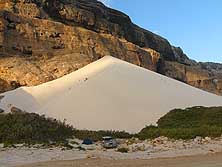
|
-
-
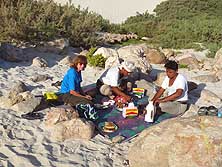
|
-
-
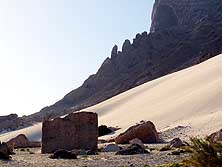
|
- 034
Our little tent and “our” car at the
- foot of the pyramid-shaped sand dune,
- where we spent the night …..
|
- 035
..... breakfast with Ahmed and
- Abdullah consisting of pita (flat bread),
- triangle cheese, honey, marmalade
- and Nescafe
|
- 036
Mountain peaks and sand
- dunes – a lovely combination
|
-
- After a little nap, we are ready to take off. Just at that moment 10 (!) LandCruiser
with tour groups come hurrying along in a cloud of dust. They are mainly from Italy, Japan and China – the first nationalities
“discovering” Socotra. We are more than happy to be able to escape the crowds.
We continue along the coast and shortly after we arrive at Arher in the Northeast. There,
the wind has blown the sand against the dark steep cliffs, forming massive dunes of
several hundred yards high – a stunning sight.
|
-
-
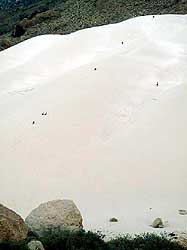
|
-
-
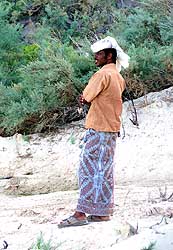
|
-
-
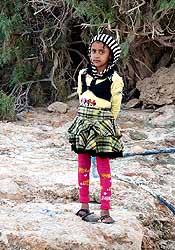
|
- 037
The tiny black dots on
- the dune are youngsters
- climbing it to slide down
|
- 038
A young Yemeni is
- waiting for a lift
|
- 039
An exemption: Girls – like
- women – don’t want to be pictured,
- but this nomad girl has no objection
|
-
- One of them is pyramid shaped. It is there, at its foot, where we pitch our Igloo tent.
At an adequate distance, a small group of Czech settles down. Our crew not having to cook
dinner for us (we never eat dinner!) disappears and spends the evening with the
neighbor’s team. After dark, we have a little cat wash at the sweet water well
between the dunes and at 8pm we are already asleep. The silence of the desert is
wonderful.
|
-
-
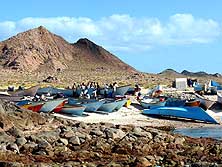
|
-
-
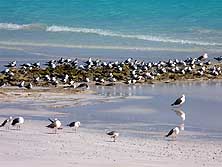
|
-
-
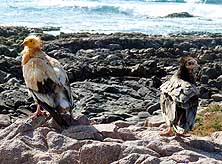
|
- 040
Irsal, a remote fishing harbor at the
- Northeastern corner of the island, sandwiched
- between desert mountains and the ocean
|
- 041
A colony of seagulls gathers
- at a sandbank along the coast …..
|
- 042
..... and a pair of omnipresent
- vultures is looking for food
|
-
- 3rd Day: February 11th, 2011:
-
- Long before sunrise we crawl out of our tent. There is no sign of another soul. We are
the only ones to enjoy the colorful spectacle of the rising sun. When the first rays of
the sun perform their game of shadow on the sand dunes, the mood is just wonderful.
Slowly, also our late risers wake up and prepare our breakfast: Pita (flat bread),
triangle cheese, honey, marmalade and Nescafe – they stick to it to the 10th day. We
do not mind – we like it!
|
-
-
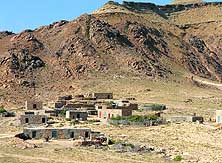
|
-
-
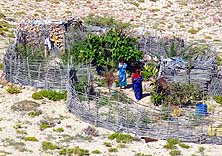
|
-
-
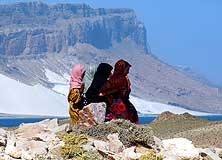
|
- 043
A mountain hamlet matching
- the colors of the desert
|
- 044
The little garden is fenced in to
- protect the vegetables from roaming goats
|
- 045
Girls are looking from a rock down to
- the road where “our” LandCruiser is parked
|
-
- One hour later we are already in Irsal, a small fishing harbor at the Northeasterly tip
of the island. Immediately we are surrounded by begging children. What a shame that even
this young tourist destination has not been spared. One boat is surrounded be
gesticulating fishermen, another is just arriving with its catch. In a row of flat sheds
of stones and palm leaves nets, buoys, containers and all the other stuff a fisherman
needs are stored. It is almost a biblical scene. Shortly after Irsal the road ends and we
backtrack the same way until Cape Dihamri where we turn off towards the mountains –
to Homhil.
|
-
-
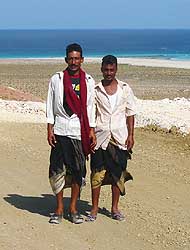
|
-
-
-
-
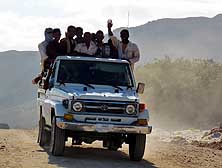
|
-
-
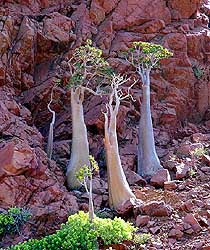
|
- 046
Two fishermen are eager
- to have their picture taken. Men
- like often to be pictured
|
- 047
On the way to anywhere –
- of course with a Toyota pickup!
|
- 048
Young bottle trees (Adenium
- obesium), also called Desert Roses,
- cling on a rock wall. They are
- accompanying us on the next two pages
|
-
- For the continuation of the 3rd day, February 11th, 2011, in Homhil - please
click here
|
-
|
More websites
from Yemen, where we visited in February 2011 the Island of Socotra: (without
our vehicle)
- Yemen car trip (from Oman to Saudi Arabia) - with
our car from May 16th to June 15th, 1996
- Part 2: Socotra Island trip in Yemen
(South) – Homhil - Aomak Beach - Wadi Daerhu - Dicksam Plateau
- Part 3: Socotra Island trip in Yemen
(West) – Qalansiya - Shouab Beach - Qadama Beach - Momi Plateau - Wadi Ayhaft
- Part 4: United Arab Emirates – Sharjah - Dubai
|
![]()
